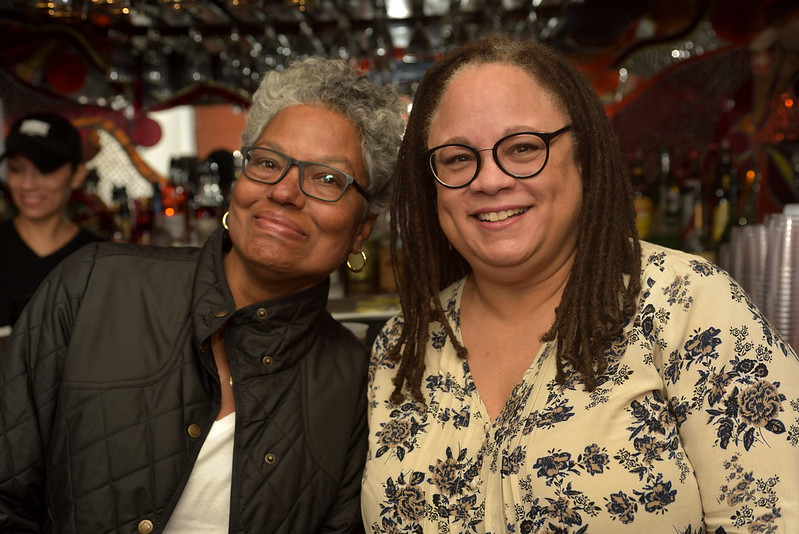
Participants at SAGE’s 2018 Women’s Dance at Henrietta Hudson. Community program like that provided by SAGE can alleviate social isolation among LGBT elders. (Photo courtesy of SAGE || Flickr)
In normative aging, the evolution from adult to older adult often parallels exposure to ageist societal attitudes and behaviors. Seniors are adapting to changing circumstances of bereavement, relocation, and the digital divide of technology. Some are exploring social media to close the gap of connection to family and friends, while adjusting to retirement and smaller social circles. With all these moving pieces, the holidays come and may cast a shadow of isolation and potential loneliness to once vibrant, active and engaged individuals.
The holiday season can bring on holiday blues or ‘winter blues’ for vulnerable populations of older adults and elders. Triggers for social isolation during the holidays included changes in family structure that may result in more significant numbers of older adults living alone, increased privacy and concealment from society. For heterosexual and sexual minority older adults (LGBTQ+), distant family may not be able to make it home for the holidays, or there may not be any family with whom to share the holidays. Holiday blues or ‘winter blues’ can trigger depression and social isolation, both of which adversely affect mental health, physical health, and emotional health. Experiencing loneliness can make it tough to see others with extra joy in their lives. Therefore, it is especially vital to embrace older adult family members, neighbors, friends and those in senior living facilities during the holiday season.
Social isolation is both a social and public health problem seen in healthy aging for older adults, but it uniquely impacts LGBTQ+ older adults. There is a decrease in economic and social resources for older LGBTQ+ adults, as well as real and perceived alienation from family and community over the lifetime. These historical and generational factors attribute to social isolation for LGBTQ+ older adults living in a heteronormative world and experiencing social exclusion, directly impacting their quality of life and well-being.
Erosheva, Kim, Emlet, & Fredriksen-Goldsen’s research reveals that older LGBTQ+ adults living in the closet were often rendered silent and unseen, and they experienced a “life of concealment.” LGBTQ+ elders were twice as likely to live alone and be single, and three to four times less likely to have children than heterosexual elders, increasing their vulnerability to social isolation. The historical risk factors of ageism combined with gender discrimination revealed to be significantly more injurious to the successful aging of sexual minority persons than heterosexuals. Belongingness to the community was vital to combat feelings of social isolation for sexual minority persons and overall increased subjective well-being.
Aging research continues to identify ongoing access to supportive and affirming communities, like SAGE, as a source of resilience which decreases loneliness and increases overall well-being. In addition, across the lifespan seasonal depression is more common than you may think. Let’s take the time to check on our seniors during this holiday season and all year long. The holiday or ‘winter blues’ experienced by over 13% of Americans can be managed with care. Let’s care for each other.
The opinions expressed in this article are those of the author and do not necessarily reflect those of the Diverse Elders Coalition.
Dr. Maria A. Glover-Wallace has over 18 years of social and human service work with marginalized urban populations. Her completed doctoral research explores the reported wellness for LGBT seniors and people of color. She has served on the board for Affinity Community Services in Chicago and the board of Project Fierce Chicago. Maria is a life coach and facilitator for small groups, couples and individuals. She continues to actively work with organizations that fight for adequate services and fair treatment of marginalized populations across this country, and also serves on the Bishop’s committee at St. Martin’s Episcopal Church in Chicago. She is currently employed as a Higher Education Enrollment Coordinator for Pearson. Maria is married to Cynthia Wallace and they have 6 children and 3 grandchildren.
References:
Erosheva, E. A., Kim, H., Emlet, C., & Fredriksen-Goldsen, K. (2016). Social networks of
lesbian, gay, bisexual, and transgender older adults. Research on Aging, 38(1), 98-123.
doi:10.1177/0164027515581859
Targum, S. D., & Rosenthal, N. (2008). Seasonal affective disorder. Psychiatry (Edgmont (Pa. : Township), 5(5), 31–33.
SAGE. (2014). Out & Visible: The experiences and attitudes of LGBT older adults, Ages 45-75. New York: Author.
Sagie, O. (2015). Predictors of well-being among older gays and lesbians. Social Indicators
Research, 120(3), 859-870. doi:10.1007/s11205-014-0608-8
Sagie, O. (2016). Well-being in older gays and lesbians: A comparison of predictors. Social
Indicators Research, 126(1), 395-409. doi:10.1007/s11205-015-0894-9
